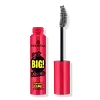What's inside
What's inside
 Key Ingredients
Key Ingredients

 Benefits
Benefits

 Concerns
Concerns

 Ingredients Side-by-side
Ingredients Side-by-side

Water
Skin ConditioningCandelilla Cera
EmollientAcacia Decurrens/Jojoba/Sunflower Seed Wax Polyglyceryl-3 Esters
EmollientCI 77499
Cosmetic ColorantCopernicia Cerifera Cera
EmollientPPG-25-Laureth-25
EmulsifyingGlycerin
HumectantStyrene/Acrylates/Ammonium Methacrylate Copolymer
Potassium Cetyl Phosphate
EmulsifyingSteareth-21
CleansingAlcohol Denat.
AntimicrobialAcacia Senegal Gum
MaskingButylene Glycol
HumectantCetyl Alcohol
EmollientSilica
AbrasiveSimethicone
EmollientSteareth-2
EmulsifyingPhenoxyethanol
PreservativeHydroxyethylcellulose
Emulsion StabilisingImidazolidinyl Urea
PreservativePropylene Glycol
HumectantMica
Cosmetic ColorantEthylparaben
PreservativeMethylparaben
PreservativeTetrasodium EDTA
Propylparaben
PreservativeDipotassium Phosphate
BufferingSodium Hyaluronate
HumectantPentaerythrityl Tetraisostearate
EmollientGlycoproteins
Skin ConditioningTriethoxycaprylylsilane
Silica Dimethyl Silylate
EmollientBiotin
AntiseborrhoeicSodium Chondroitin Sulfate
Skin ConditioningAtelocollagen
Skin ConditioningWater, Candelilla Cera, Acacia Decurrens/Jojoba/Sunflower Seed Wax Polyglyceryl-3 Esters, CI 77499, Copernicia Cerifera Cera, PPG-25-Laureth-25, Glycerin, Styrene/Acrylates/Ammonium Methacrylate Copolymer, Potassium Cetyl Phosphate, Steareth-21, Alcohol Denat., Acacia Senegal Gum, Butylene Glycol, Cetyl Alcohol, Silica, Simethicone, Steareth-2, Phenoxyethanol, Hydroxyethylcellulose, Imidazolidinyl Urea, Propylene Glycol, Mica, Ethylparaben, Methylparaben, Tetrasodium EDTA, Propylparaben, Dipotassium Phosphate, Sodium Hyaluronate, Pentaerythrityl Tetraisostearate, Glycoproteins, Triethoxycaprylylsilane, Silica Dimethyl Silylate, Biotin, Sodium Chondroitin Sulfate, Atelocollagen
Water
Skin ConditioningParaffin
PerfumingSynthetic Beeswax
Emulsion StabilisingSteareth-20
CleansingCopernicia Cerifera Wax
Alcohol Denat.
AntimicrobialSteareth-2
EmulsifyingGlyceryl Behenate
EmollientCetyl Alcohol
EmollientTocopheryl Acetate
AntioxidantTocopherol
AntioxidantJojoba Esters
EmollientMethylpropanediol
SolventHydroxyethylcellulose
Emulsion StabilisingCaprylyl Glycol
EmollientSimethicone
EmollientPolyurethane-14
Amp-Acrylates Copolymer
Aminomethyl Propanediol
BufferingAminomethyl Propanol
BufferingIsopropyl Acetate
SolventBHT
AntioxidantPhenoxyethanol
PreservativeCI 77499
Cosmetic ColorantWater, Paraffin, Synthetic Beeswax, Steareth-20, Copernicia Cerifera Wax, Alcohol Denat., Steareth-2, Glyceryl Behenate, Cetyl Alcohol, Tocopheryl Acetate, Tocopherol, Jojoba Esters, Methylpropanediol, Hydroxyethylcellulose, Caprylyl Glycol, Simethicone, Polyurethane-14, Amp-Acrylates Copolymer, Aminomethyl Propanediol, Aminomethyl Propanol, Isopropyl Acetate, BHT, Phenoxyethanol, CI 77499
Ingredients Explained
These ingredients are found in both products.
Ingredients higher up in an ingredient list are typically present in a larger amount.
Alcohol Denat. is an alcohol with a denaturant property. It is created by mixing ethanol with other additives.
This ingredient gets a bad rep because it is irritating and drying - mostly due to its astringent property. Astringents draw out natural oils in tissue, constricting pores and leaving your skin dried out.
However, alcohol denat. is not all that bad.
Due to its low molecular weight, alcohol denat. tends to evaporate quickly. One study on pig skin found half of applied alcohol evaporated in 10 seconds and less than 3% stayed on skin.
This also helps other ingredients become better absorbed upon application.
Studies are conflicted about whether this ingredient causes skin dehydration. One study from 2005 found adding emollients to propanol-based sanitizer decreased skin dryness and irritation. Another study found irritation only occurs if your skin is already damaged.
Small amounts of alcohol are generally tolerated by oily skin or people who live in humid environments.
The rule of thumb is if this alcohol is near the end of an ingredients list, it will probably not affect your skin much.
Also...
This ingredient has antimicrobial and solvent properties.
The antimicrobial property helps preserve products and increase their shelf life. As a solvent, it helps dissolve other ingredients.
Other types of astringent alcohols include:
Learn more about Alcohol Denat.Cetyl Alcohol is a fatty alcohol. Fatty Alcohols are most often used as an emollient or to thicken a product.
Its main roles are:
Though it has "alcohol" in the name, it is not related to denatured alcohol or ethyl alcohol.
The FDA allows products labeled "alcohol-free" to have fatty alcohols.
Learn more about Cetyl AlcoholCi 77499 is also hydrated iron III oxide. It is created from mixing red and black iron oxides. This helps give shades of darkness to a product.
Iron III oxides are classified as inorganic chemicals for coloring.
Hydroxyethylcellulose is used to improve the texture of products. It is created from a chemical reaction involving ethylene oxide and alkali-cellulose. Cellulose is a sugar found in plant cell walls and help give plants structure.
This ingredient helps stabilize products by preventing ingredients from separating. It can also help thicken the texture of a product.
This ingredient can also be found in pill medicines to help our bodies digest other ingredients.
Learn more about HydroxyethylcellulosePhenoxyethanol is a preservative that has germicide, antimicrobial, and aromatic properties. Studies show that phenoxyethanol can prevent microbial growth. By itself, it has a scent that is similar to that of a rose.
It's often used in formulations along with Caprylyl Glycol to preserve the shelf life of products.
Simethicone is a silicone. It is an emollient and used to reduce foaming in a product. It is also often used to coat sunscreen ingredients for better spreadability.
This ingredient is created by mixing dimethylpolysiloxane and hydrated silica.
Steareth-2 is a waxy compound used to emulsify ingredients. It is created from polyethylene glycol and stearyl alcohol.
The 2 stands for the number of ethylene oxide units used to create this ingredient.
Water. It's the most common cosmetic ingredient of all. You'll usually see it at the top of ingredient lists, meaning that it makes up the largest part of the product.
So why is it so popular? Water most often acts as a solvent - this means that it helps dissolve other ingredients into the formulation.
You'll also recognize water as that liquid we all need to stay alive. If you see this, drink a glass of water. Stay hydrated!
Learn more about Water